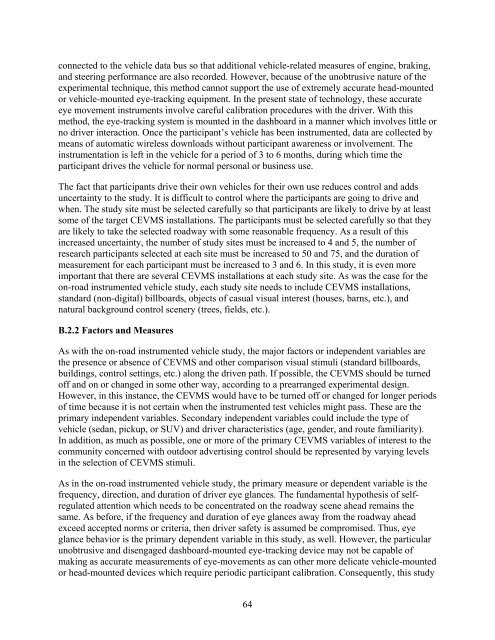The Effects of Commercial Electronic Variable Message Signs ...
The Effects of Commercial Electronic Variable Message Signs ...
The Effects of Commercial Electronic Variable Message Signs ...
Create successful ePaper yourself
Turn your PDF publications into a flip-book with our unique Google optimized e-Paper software.
connected to the vehicle data bus so that additional vehicle-related measures <strong>of</strong> engine, braking,<br />
and steering performance are also recorded. However, because <strong>of</strong> the unobtrusive nature <strong>of</strong> the<br />
experimental technique, this method cannot support the use <strong>of</strong> extremely accurate head-mounted<br />
or vehicle-mounted eye-tracking equipment. In the present state <strong>of</strong> technology, these accurate<br />
eye movement instruments involve careful calibration procedures with the driver. With this<br />
method, the eye-tracking system is mounted in the dashboard in a manner which involves little or<br />
no driver interaction. Once the participant’s vehicle has been instrumented, data are collected by<br />
means <strong>of</strong> automatic wireless downloads without participant awareness or involvement. <strong>The</strong><br />
instrumentation is left in the vehicle for a period <strong>of</strong> 3 to 6 months, during which time the<br />
participant drives the vehicle for normal personal or business use.<br />
<strong>The</strong> fact that participants drive their own vehicles for their own use reduces control and adds<br />
uncertainty to the study. It is difficult to control where the participants are going to drive and<br />
when. <strong>The</strong> study site must be selected carefully so that participants are likely to drive by at least<br />
some <strong>of</strong> the target CEVMS installations. <strong>The</strong> participants must be selected carefully so that they<br />
are likely to take the selected roadway with some reasonable frequency. As a result <strong>of</strong> this<br />
increased uncertainty, the number <strong>of</strong> study sites must be increased to 4 and 5, the number <strong>of</strong><br />
research participants selected at each site must be increased to 50 and 75, and the duration <strong>of</strong><br />
measurement for each participant must be increased to 3 and 6. In this study, it is even more<br />
important that there are several CEVMS installations at each study site. As was the case for the<br />
on-road instrumented vehicle study, each study site needs to include CEVMS installations,<br />
standard (non-digital) billboards, objects <strong>of</strong> casual visual interest (houses, barns, etc.), and<br />
natural background control scenery (trees, fields, etc.).<br />
B.2.2 Factors and Measures<br />
As with the on-road instrumented vehicle study, the major factors or independent variables are<br />
the presence or absence <strong>of</strong> CEVMS and other comparison visual stimuli (standard billboards,<br />
buildings, control settings, etc.) along the driven path. If possible, the CEVMS should be turned<br />
<strong>of</strong>f and on or changed in some other way, according to a prearranged experimental design.<br />
However, in this instance, the CEVMS would have to be turned <strong>of</strong>f or changed for longer periods<br />
<strong>of</strong> time because it is not certain when the instrumented test vehicles might pass. <strong>The</strong>se are the<br />
primary independent variables. Secondary independent variables could include the type <strong>of</strong><br />
vehicle (sedan, pickup, or SUV) and driver characteristics (age, gender, and route familiarity).<br />
In addition, as much as possible, one or more <strong>of</strong> the primary CEVMS variables <strong>of</strong> interest to the<br />
community concerned with outdoor advertising control should be represented by varying levels<br />
in the selection <strong>of</strong> CEVMS stimuli.<br />
As in the on-road instrumented vehicle study, the primary measure or dependent variable is the<br />
frequency, direction, and duration <strong>of</strong> driver eye glances. <strong>The</strong> fundamental hypothesis <strong>of</strong> selfregulated<br />
attention which needs to be concentrated on the roadway scene ahead remains the<br />
same. As before, if the frequency and duration <strong>of</strong> eye glances away from the roadway ahead<br />
exceed accepted norms or criteria, then driver safety is assumed be compromised. Thus, eye<br />
glance behavior is the primary dependent variable in this study, as well. However, the particular<br />
unobtrusive and disengaged dashboard-mounted eye-tracking device may not be capable <strong>of</strong><br />
making as accurate measurements <strong>of</strong> eye-movements as can other more delicate vehicle-mounted<br />
or head-mounted devices which require periodic participant calibration. Consequently, this study<br />
64

















